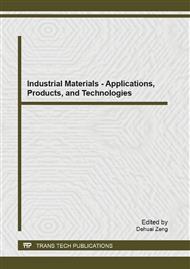[1]
Perkins R.W. and Casey L.A. Radioxenons: Their role in monitoring a comprehensive test ban treaty. United States Department of Energy. (1996).
DOI: 10.2172/266641
Google Scholar
[2]
Ad Hoc Committee on a Nuclear Test Ban. International Monitoring System Expert Group Report based on Technical Discussions held from 6 February to 3 March 1995[R]. CD/NTB /WP. 224. (1995).
Google Scholar
[3]
Seok-Jin Son, Jung-Sik Cho, I Ko-Yeon Choo, etc. Development of carbon dioxide adsorben -ts using carbon materials prepared from coconut shell[J]. Korean Journal of Chemical Engineering, 2005, 22(2): 291-297.
DOI: 10.1007/bf02701500
Google Scholar
[4]
Phadnis N P. Activated carbons-carbonaceous adsorbents in technology and environmental protection[J]. Chemical engineering world, 1995, 30(2): 69-71.
Google Scholar
[5]
KITANI S, TAKADA J. Adsorption of Krypton and Xenon on Various Adsorbents[J]. Journal of Nuclear Science and Technology, 1965, 2 (2) : 51-56.
DOI: 10.1080/18811248.1965.9732158
Google Scholar
[6]
Bowyer T W, Abel K H. Application of Nuclear Techniques to Non-Proliferation Treaties and Weapons Detection[J]. Journal of Radioanalytical and Nuclear Chemistry, 1998, 235(1-2): 77-82.
Google Scholar
[7]
J.P. Fontaine,F. Pointurier,X. Blanchard, etc. Atmospheric xenon radioactive isotope monitoring [J]. Journal of Environment Radioactivit -y , 2004, 72(1-2): 129-135.
DOI: 10.1016/s0265-931x(03)00194-2
Google Scholar
[8]
Wang Hongxia et al: Adsorption Properties of Xenon by Coconut Base Activated Charcoal in Ambient Temperature. Atomic Energy Science and Technology. 2009, 43(12): 1091 -1094.
Google Scholar
[9]
Feng Shujuan, Zhou Chongyang, Zhou Guoqing(. Dynamic Adsorption Property of Xenon on Activated Carbon and Carbon Molecular Sieves. Journal of Nuclear and Radiochemistry. 2010, 32(5): 274-279.
Google Scholar
[10]
Deng Jiyong et al. PROPERTIES OF XENON ADSORPTION OF ACTIVATED CARBON FIBERⅠ-influence of different based materials on amounts of adsorption. Ion Exchange and Adsorption. 1999, 15(5): 464-467.
Google Scholar
[11]
Zhang Lixing et al: Factors that affect the dynamic adsorption of xenon on activated carbon fibers. New Carbon Materials. 2005, 20(4): 369-372.
Google Scholar
[12]
Chen Zhanying et al: Dynamic Adsorption and Desorption Properties of Xenon on Activated Carbon Fiber. Journal of Inorganic Materials. 2006, 21(1):81-86.
Google Scholar
[13]
Wang Yalong , Zhang Haitao, Wang Xuehui, etc. Study of Static Adsorption Capacity of ACF for Xenon at 201 K. Chemical Research in Chinese Universities. 2002, 18(2): 216-220.
Google Scholar
[14]
Degn Jiyong et al: Xenon Adsorption Mechanism of Activated Carbon Fibers. Journal of Inorganic Materials. 2004, 19(1): 177-182.
Google Scholar
[15]
Wang Yalong. et al. Study on the Sampler for Radioxenon Isotopes and its Sampling Efficiency Calibration. Journal of Nuclear and Radiochemistry. 2005, 27 (2): 113-116.
Google Scholar
[16]
J. Watermann and B. Boddenberg: Isosteric heats of adsorption of xenon in silver-exchanged Y zeolites. ZEOLITES. 1993, 13(6): 427-429.
DOI: 10.1016/0144-2449(93)90115-j
Google Scholar
[17]
Steven M. Kuznicki: Xenon Adsorption on Modified ETS-10. Journal of Physical Chemistry C. 2007, 111 (4): 1560-1562.
Google Scholar
[18]
Carl G. Saxton, etc: Xenon adsorption in synthetic chabazite zeolites. Microporous and Mesoporous Materials, 2010, 129(1-2): 68-73.
DOI: 10.1016/j.micromeso.2009.08.034
Google Scholar
[19]
A. Fomkin and A.L. Pulin: Adsorption deformation of zeolite NaX at high pressures of xenon . Ussian Chemical Bulletin. 1996, 45(2): 321-323.
DOI: 10.1007/bf01433964
Google Scholar
[20]
Feng Shujuan, Zhou Chongyang, Zhou Guoqing: Dynamic Adsorption Property of Xenon on Activated Carbon and Carbon Molecular Sieves. Journal of Nuclear and Radiochemistry. 2010, 32(2): 274-279.
Google Scholar
[21]
Feng Shujuan, Zhou Chongyang, Zhou Guoqing:. Dynamic Adsorption and Desorption of Radon on Carbon Molecular Sieve. Radiation Protection, 2010, 32(2): 113-116.
Google Scholar
[22]
W. Rudzinski: Adsorption of argon and Xenon on graphite. Czechoslovak Journal of Physics. 1973, 23(4): 488-490.
Google Scholar
[23]
Dinesh S. Rawat, et al: Adsorption of Xenon on Purified HiPco Single Walled Carbon Nanotubes Langmuir. 2006, 22(1): 234-238.
DOI: 10.1021/la052127d
Google Scholar
[24]
Chen Shuixia,Jing Ying, et al: Studies on the Structure of Several Activated Carbon Fibers and their Xenon Adsorption Properties. Chinese High Technology Letters, 2002, 12 (11): 67-72.
Google Scholar


